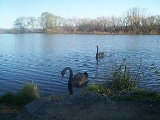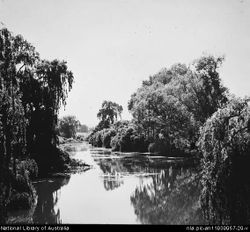
Molonglo River
Encyclopedia

Great Dividing Range
The Great Dividing Range, or the Eastern Highlands, is Australia's most substantial mountain range and the third longest in the world. The range stretches more than 3,500 km from Dauan Island off the northeastern tip of Queensland, running the entire length of the eastern coastline through...
of eastern Australia
Australia
Australia , officially the Commonwealth of Australia, is a country in the Southern Hemisphere comprising the mainland of the Australian continent, the island of Tasmania, and numerous smaller islands in the Indian and Pacific Oceans. It is the world's sixth-largest country by total area...
in the state of New South Wales
New South Wales
New South Wales is a state of :Australia, located in the east of the country. It is bordered by Queensland, Victoria and South Australia to the north, south and west respectively. To the east, the state is bordered by the Tasman Sea, which forms part of the Pacific Ocean. New South Wales...
. Its source is on the other side of the mountain range from where the Shoalhaven River
Shoalhaven River
The Shoalhaven River is a river rising from the Southern Tablelands and flowing into the ocean near Nowra on the South Coast of New South Wales, Australia.- History :...
rises, in Tallaganda state forest at ~1200 metres altitude. The Molonglo River flows from south to north before turning northwest, through the outskirts of the New South Wales town of Queanbeyan, where it picks up its major tributary the Queanbeyan River
Queanbeyan River
The Queanbeyan River is a tributary of the Molonglo River and part of Murray-Darling Basin. The river is 70 kilometres in length and the river catchment is 96,000 hectares in size...
, and then continues through the nation's federal capital city of Canberra
Canberra
Canberra is the capital city of Australia. With a population of over 345,000, it is Australia's largest inland city and the eighth-largest city overall. The city is located at the northern end of the Australian Capital Territory , south-west of Sydney, and north-east of Melbourne...
, where it has been dammed to form Lake Burley Griffin
Lake Burley Griffin
Lake Burley Griffin is an artificial lake in the centre of Canberra, the capital of Australia. It was completed in 1963 after the Molonglo River—which ran between the city centre and Parliamentary Triangle—was dammed...
. It then flows on to empty into the Murrumbidgee River
Murrumbidgee River
The Murrumbidgee River is a major river in the state of New South Wales, Australia, and the Australian Capital Territory . A major tributary of the Murray River, the Murrumbidgee flows in a west-northwesterly direction from the foot of Peppercorn Hill in the Fiery Range of the Snowy Mountains,...
to the northwest of Canberra. Over its course the Molonglo River alternates between long broad floodplains and narrow rocky gorges several times. One of these floodplains is called the Molonglo Plain.
Origin of name
The river's name was recorded as the "Yeal-am-bid-gie" in 1820 by the explorer Charles ThrosbyCharles Throsby
Charles Throsby was an Australian explorer, pioneer and parliamentarian. He opened up much new land beyond the Blue Mountains for colonial settlement. He was a grazier, and became a prominent member of New South Wales society.- Early life :...
. This was probably the collective local Ngunnawal language
Ngunnawal language
Ngunnawal or Ngunawal is an Australian Aboriginal language, the traditional language of the Ngunawal people.-Classification:Ngunawal is currently classified as a sub-tribe of the larger Ngarigu/Ngarigo dialect area that covers the limestone plains of Monaro/Maneroo in NSW to ACT across the Monaro...
name for the river. (The suffix "bidgee" was common in Aboriginal names for rivers in the Canberra area and presumably means "water" or "river".) The Moolinggolah people of the district around Captains Flat
Captains Flat, New South Wales
Captains Flat is a town in the Southern Tablelands of New South Wales, Australia, in Palerang Shire. It is south of Queanbeyan.It is suggested that a bullock named "Captain" from Foxlow station, 12 km away, grazed here and hence the place name....
probably gave the Molonglo its name. Where the river flowed through what is now Canberra, it was probably known after the Ngambri
Ngambri
Ngambri or Kamberri is the name of the ancestral group and their descendants after whom the capital of Australia, Canberra, is named.Since the Native Title Act was passed in 1994, the mainly Yass- and Boorowa-based Ngunnawal have been asserting their claims to be the 'rightful traditional...
people, transcribed as Kembury, Canberry, and other transcription variations.
History
In the early years of European settlement both the Molonglo and the Queanbeyan were known as the "Fish River" for the abundance of native fish in them. The Molonglo was renowned as a beautiful river with excellent fishing for native Murray CodMurray Cod
The Murray cod is a large Australian predatory freshwater fish of the Maccullochella genus and the Percichthyidae family. Although the species is a called cod in the vernacular, it is not related to the northern hemisphere marine cod species...
, Golden Perch
Golden perch
The golden perch, Macquaria ambigua, is an Australian native freshwater fish, primarily of the Murray-Darling river system. It is not a true perch of the genus Perca....
and Silver Perch
Silver Perch
Silver perch is a medium sized freshwater fish endemic to the Murray-Darling river system in south-eastern Australia. The scientific name comes from an aboriginal name for the species recorded by Major Mitchell on his 1832 expedition. It is not a perch, being a grunter in the family Terapontidae...
. Sadly, this abundance of native fish did not last. In the 1930s and 1940s, mine tailings
Tailings
Tailings, also called mine dumps, slimes, tails, leach residue, or slickens, are the materials left over after the process of separating the valuable fraction from the uneconomic fraction of an ore...
at Captains Flat
Captains Flat, New South Wales
Captains Flat is a town in the Southern Tablelands of New South Wales, Australia, in Palerang Shire. It is south of Queanbeyan.It is suggested that a bullock named "Captain" from Foxlow station, 12 km away, grazed here and hence the place name....
twice collapsed into the upper reaches of the river, eradicating all native fish and most other aquatic life downstream from the site. Despite government funded rehabilitation programs in 1976, some toxic leachates still enter the river from the Captain's Flat mine site.
Consequently, when Lake Burley Griffin
Lake Burley Griffin
Lake Burley Griffin is an artificial lake in the centre of Canberra, the capital of Australia. It was completed in 1963 after the Molonglo River—which ran between the city centre and Parliamentary Triangle—was dammed...
was built upon the Molonglo and filled in 1964, the waters were devoid of native fish. Restocking commenced in the 1970s and continued through 1980s have re-established Murray Cod
Murray Cod
The Murray cod is a large Australian predatory freshwater fish of the Maccullochella genus and the Percichthyidae family. Although the species is a called cod in the vernacular, it is not related to the northern hemisphere marine cod species...
and Golden Perch
Golden perch
The golden perch, Macquaria ambigua, is an Australian native freshwater fish, primarily of the Murray-Darling river system. It is not a true perch of the genus Perca....
in the lake and a short stretch of river upstream. A large stretch of the Molonglo still holds nothing but introduced fish species and is still waiting for the native fish species to be re-established by stockings.
Selected References
Lintermans, M. (2000) The Status of Fish in the Australian Capital Territory : A Review of Current Knowledge and Management Requirements. Technical Report No. 15. Environment ACT, Canberra.See also
- London Bridge (karst)London Bridge (karst)London Bridge is a limestone karst near Canberra, Australia that consists of a limestone arch hollowed out by the Molonglo River.It was first discovered by the European explorers Captain Mark Currie, Brigadier Major John Ovens, Joseph Wild and accompanied by two nameless aboriginal guides in 1822...

